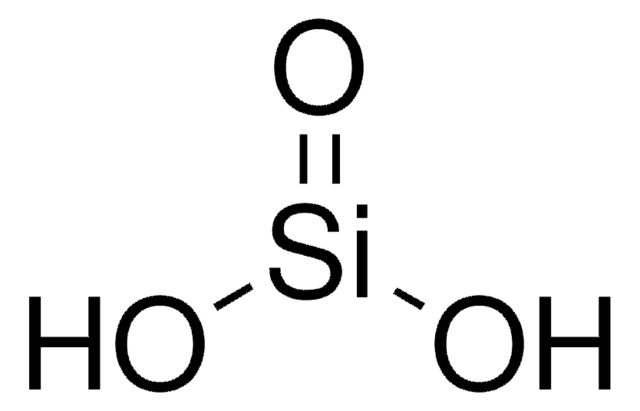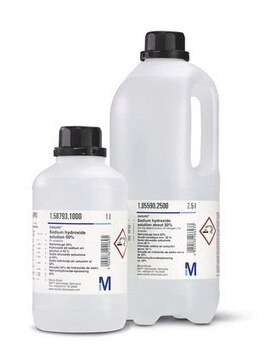306363
Silicic acid
powder, −80 mesh
Se connecterpour consulter vos tarifs contractuels et ceux de votre entreprise/organisme
About This Item
Numéro CAS:
Numéro CE :
Numéro MDL:
Code UNSPSC :
12352301
ID de substance PubChem :
Nomenclature NACRES :
NA.21
Produits recommandés
Forme
powder
Perte
<16% loss on ignition
Taille des particules
−80 mesh
Chaîne SMILES
O[Si](O)=O
InChI
1S/H2O3Si/c1-4(2)3/h1-2H
Clé InChI
IJKVHSBPTUYDLN-UHFFFAOYSA-N
Vous recherchez des produits similaires ? Visite Guide de comparaison des produits
Application
Silicic acid is a hydrophilic inorganic material that can be used as a zirconium phosphate additive to enhance proton conductivity in the inorganic-organic composite membranes. It can also be used as a binder for the electrodes of thermal batteries.
Code de la classe de stockage
11 - Combustible Solids
Classe de danger pour l'eau (WGK)
WGK 3
Point d'éclair (°F)
Not applicable
Point d'éclair (°C)
Not applicable
Faites votre choix parmi les versions les plus récentes :
Déjà en possession de ce produit ?
Retrouvez la documentation relative aux produits que vous avez récemment achetés dans la Bibliothèque de documents.
Les clients ont également consulté
Silicic acid polymerization catalyzed by amines and polyamines.
Mizutani T, et al.
Bulletin of the Chemical Society of Japan, 71(8), 2017-2022 (1998)
The Intimate Role of Imidazole in the Stabilization of Silicic Acid by a pH-Responsive, Histidine-Grafted Polyampholyte.
Demadis KD, et al.
Chemistry of Materials, 27(19), 6827-6836 (2015)
T I Nikoforova
Voprosy kurortologii, fizioterapii, i lechebnoi fizicheskoi kultury, (3)(3), 16-21 (2013-07-04)
This article is focused on the benefits of drug-free therapeutic technologies, such as the use of artificial general siliceous baths for the treatment of patients with arterial hypertension. This approach results in the anti-hypertensive effect simultaneous with the correction of
Li-Na Niu et al.
FASEB journal : official publication of the Federation of American Societies for Experimental Biology, 26(11), 4517-4529 (2012-08-04)
Traditional bone regeneration strategies relied on supplementation of biomaterials constructs with stem or progenitor cells or growth factors. By contrast, cell homing strategies employ chemokines to mobilize stem or progenitor cells from host bone marrow and tissue niches to injured
Tsuyoshi Yamamoto et al.
Journal of plant research, 125(6), 771-779 (2012-04-25)
Rice (Oryza sativa L.) is a typical Si-accumulating plant and is able to accumulate Si up to >10 % of shoot dry weight. The cell wall has been reported to become thicker under Si-deficient condition. To clarify the relationship between Si
Notre équipe de scientifiques dispose d'une expérience dans tous les secteurs de la recherche, notamment en sciences de la vie, science des matériaux, synthèse chimique, chromatographie, analyse et dans de nombreux autres domaines..
Contacter notre Service technique











